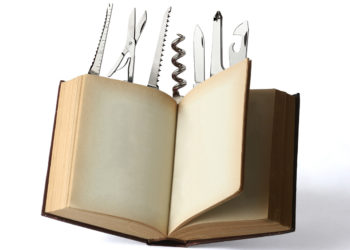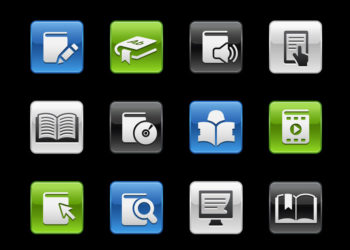Books are for use. I can’t imagine that the readers of The Scholarly Kitchen don’t immediately recognize that mantra as one of Ranganathan’s Five Laws. Perhaps “mantra” isn’t how the rest of you might characterize it, but the sentence has been resonating in my head as I work on downsizing in my home. Books are for use. Use consists of a spectrum of tasks and actions – reading, checking a reference, annotating, etc. Practically speaking, books should be produced and housed in such fashion as will support maximal use. It is undoubtedly what sensible readers expect.
A report was released in September by the Book Manufacturing Institute (BMI), 2022 Trends in Book Manufacturing. Cognizant of supply chain issues as well as some of the recommended advice for countering those issues as offered by Ken Brooks of Publishing Technology Partners, I read the report with interest. Not surprisingly, the major challenges noted by the BMI were on-shore vs offshore printing capacity in North America, inflation, paper supply and the cost of labor. The report also noted that different sectors (trade, professional, juvenile, religious publishing) have specific manufacturing needs for printing, binding and finishing. None of this will surprise Scholarly Kitchen readers.

Readers have their own thoughts about how books should look and feel in the hand. Leigh Hunt in his essay “My Books” writes:
But I confess my weakness in liking to see some of my favourite purchases neatly bound…For most of these I like a plain, good, old binding, never mind how old, provided it wears well, but my Arabian Nights may be bound in as fine and flowery a style as possible, and I should love an engraving to every dozen pages.”
In listings from rare book sellers, collectors brood over descriptions like this: Green pictorial publishers cloth hardbound, gilt title/white title stamped/embossed on spine cover/front board, color and black/white lithograph illustrated text,
In looking for visuals on current book manufacturing processes, I came across a series of video assessments of printed Bibles and the associated production values. Bibles occupy a unique market niche in the context of physical printing and binding. As one name-brand Bible publisher’s marketing materials put it, their output should be viewed as “distant cousins to books produced in a purely mechanized fashion”. The same promotional package included a card showing flags of the countries that supply the materials used in producing the physical Bible. The paper originates from France, the calfskin from Germany, the ribbon bookmarks from the UK, etc. Specialty printing houses, such as Royal Jongbloed and 2K Denmark, cater to very particular requirements. There’s an excellent case study written up on the 2K Denmark site. These printing houses work with other publishers as well, but their websites frequently stress their capabilities in this particular niche due to the precise demands.
Members of the Bible publishing community were early innovators in coping with the transition to digital, recognizing the role of the platform, mobile apps, and more. Simultaneously, faced with the expansion of formats, Bible publishers were dealing with an equally competitive marketplace with product offerings ranging from free, web-based Bible portals to limited editions, such as those from Cambridge University Press. A recently launched Society for Bible Craftsmanship plans to offer annual awards for excellence in Bible design, typography, and production as a further means of heightening awareness of the attention paid to the physical elements.
So why bring this up here in The Scholarly Kitchen? In part because so much attention in recent months has been given over to the concerns associated with digital information environments rather than with how our relationship with print is changing. Print is still part of the landscape in scholarly publishing but there are limitations. There’s the basic question of necessity, given that readers learned to live with digital editions throughout the course of a global pandemic. Is paper-based output either environmentally sound or sustainable? Even as they continue to purchase some print, libraries are repurposing their available space, gradually shifting print stacks to off-site storage, and developing a collective model of shared print. Perhaps one of its most damning characteristics, printed text presents a barrier to those with a variety of disabilities.
Publishers have to weigh the viability of continuing support for print. Who will be the buyer and will there be sufficient numbers to keep print affordable? It’s not surprising that academic libraries and the vendors who serve them quietly emphasize digital as the preferable option. Books are for use. Digital will serve the needs of those who follow a linear path through longform content as well as those who merely need to do a quick look-up. It’s an economical solution, where print may truly not be.
But the cost of producing a book is not transparent to the user community and publishers can be cagey in discussing the factors that influence pricing of their print product. Conventional discussions may mention well-known elements like page count or half-tones, but there’s very little practical information shared with consumers regarding shifts in the supply chain or production workflows. Users just know that print is increasingly expensive.
I casually drew three printed titles from university presses from my stack. Two are in hardcover and one is in paperback. All three are collections of essays – one in history, one in literature and one in library and information science. The titles in literature and library science have no illustrations of any sort; the history essays include no half-tones and have only a minimal number of tables and black and white illustrations. (Certainly, nothing like Hunt’s request for engravings every ten pages.) The range in page counts is not dramatic (less than a hundred pages difference across the three) but in no instance was any publisher using coated stock.
Production values for these print titles reflect some attention to anticipated durability. The hardcovers have attractive dust jackets but underneath, the binding materials and the lettering on spines are basic and utilitarian. The pages in the paperback are glued. The materials may withstand active use if not abused, but use always takes its toll. Unlike a leather-bound Bible preserved as an heirloom, these printed volumes are not perceived as sacred but as reproducible at point of need and pricing reflects that. Pricing ranged from $70 for the hardcovers down to $37 for the paperback. (If it makes any difference, all three titles were purchased via Amazon and thus were available to the general consumer at a moderate discount. Not all three had a Kindle edition at the time of purchase.)
Publishers and libraries have unspoken assumptions as to what degree of reader access is sufficient, but when I attended a recent industry webinar, numerous voices in the chat muttered about lack of access to books. There are many prospective users precluded from use of digital resources on or off campus, due to licensing restrictions. Those restrictions keep costs down for institutions, but are less satisfactory for readers whose use is legitimate – adjunct faculty, alumni, freelancers, contractors, even local residents who find themselves poorly served by weakened public libraries. Seventy dollars for a hardcover is not realistically affordable for the individual, but without access to the digital, where do we expect such users to go?
The economics are harsh. Initial print runs continue to shrink and across the board, the supply chain needs to invest and innovate. Meanwhile, we expect patrons at all levels to cope with a variety of work-around solutions. In this environment, as business models are driven for scale and budgetary axes trim to the bone, a percentage of worthwhile titles will never achieve full usage.
Moving forward, how do we live up to that law that books are for use? Who are the readers that we push to the fringe? Do the solutions that work on a cost basis for libraries and publishers actually serve the best interests of readers? We need to communicate our realities to readers. Because they USE our books.
Discussion
9 Thoughts on "Books Are For Use and What That Means"
I’m going to disagree with your premise that it’s universally agreed that “books should be produced and housed in such fashion as will support maximal use”. I would modify that “maximal” to instead be something like “optimal”. Academic librarians have long understood that there is an unescapable tradeoff in the print world between what we call “access” versus “preservation”. In order to preserve a physical artifact for future users, there needs to be some limitation on the amount of wear and tear on it by current users. We absolutely want patrons who need a particular book to use it. However, we don’t want it be used “frivolously” if it means that a future patron who would have serious use won’t be able to get to it because the frivolous user damaged it too much. Of course, the devil is in the details – who judges what is a frivolous versus serious use? Sometimes a little bit of what economists/psychologists now call “friction”, like having to get a book retrieved from offsite storage, is the right answer. Or other staff mediated options that are common with access-controlled special collections. One of the things I love about ebooks is that the preservation issue is completely unlinked from the volume of use. They introduce a different set of preservation issues instead, but at least they don’t incentivize librarians to put friction between the work and the patron.
Many of my older books, even those in small press runs from LIS publishers, were quite well produced and still thrive on my shelves. Newer books mostly glued, fall apart after light use. I buy few new physical books now because they do not hold up.
Thanks, Jill. I have a 15 year old daughter. She only reads print books, as do her friends. Its a break from being on their phones and laptops all the time. All her school reading (except for literature) is online. She does not have a single textbook. It’s quite the same for me. I have no idea how to print a document at my company HQ and my home printer is fickle. Picking up a print book– devoid of distractions like notifications and dings–is a welcome relief.
As a sign of growing sales in print, despite all the trends that should be pushing it down, Barnes & Noble just announced that they are opening the largest new bookstore in America in my town. B&N was in this same shopping plaza until it closed at the beginning of the pandemic. Now it’s coming back with a larger 28,000 sq foot imprint.
As to the production value… I have refused to buy books that have super tiny and hard to read fonts. I don’t know what happened to the book designer industry, but 8 pt fonts are tough on everyone. I love the phrase “books are made to be used.” I was a heavy annotator. I dog-ear the pages. I break the spine. I have no book reading regrets.
If I were to trim down my laundry list of complaints in this area to just one, it would probably be that publishers make it hard for would-be customers to learn about the physical aspects of a book before buying it.
I can’t remember a time when we weren’t told whether a book for sale was a paperback or a hardback, but it’s like pulling teeth to find out whether a copy of, say, Subsystems of Second Order Arithmetic is the original version or a poorly-printed POD knockoff. To some of us, the difference between the latter is much more significant than between the former, but I have to place a special query with Cambridge University Press customer service to find out the bad news that POD copies are all they have left.
And, of course, it’s not just publishers but retailers, also. At times, Amazon’s erratic policy on user reviews has actually forbidden those reviews to discuss the physical aspects of a book purchased from them.
If books were only for use, I would have a hard time justifying the size of my personal library of some 4,000 books, about 1,500 of which are books I acquied for the academic publishers I worked for over a fifty-year career, most of those years at two university presses, Princeton and Penn State. But I do have them organized, library style, by subject area and alphabetically by author’s last name for easy retrieval should I ever need to consult them again. The big question facing me, at age 79, is who is going to want these books after I die? Almost all are in mint condition, and some of them are still in shrink wrap, being books that I had already read once in prepublication form as submitted manuscripts.
That question is easier to answer for the 100 or so rare books I own because I have already designated in my will that they are to be sold at auction and the proceeds used to pay the college tuitions of my four grandchildren.
One of those books, a part of Acquinas’s Summa Theologica published in Venice in 1483, is the best produced book I have in my entire collection of both rare and new books, being bound in vellum and printed on paper that looks as fresh today as it was more than 500 years ago. Printing standards have been in a slow decline ever since the 1400s!
My former boss at Princeton University Press, Herb Bailey, at least helped correct that downward trajectory when he prevailed upon the industry to adopt paper standards that replaced acidic with acid-free paper, extending the life span of books by decades.
Probably the decline started even earlier when instead of the stone tablets on which the Ten Commandments appeared, the world resorted to paper.
As for digital versus paper, when we launched the Romance Studies Series as an open-access initiative at Penn State Press in 2005, we quickly discovered the need to offer a POD option because the authors wanted print copies to give to their grandparents.
The one reason I value digital today, besides ease of searching, is the ability to enlarge the print. Many of us older folks have reached the point at which we feel excluded from print publications because the type size has become too small to read. That includes not just books (especially footnotes!) but also newspapers, magazines, and restaurant menus, which are impossible to read in restaurants where the lighting is dim. These days I always carry a flashlight whenever I go to such a restaurant.
“Digital will serve the needs of those who follow a linear path through longform content…” Making the text available, yes. But the retention/comprehension outcomes differ.
From the research I’ve encountered, it seems quite clear that the outcomes from reading digitally are not the same as reading in print. The gaps in comprehension are widest for longform informational content.
There are a LOT of variables, but I think it’s important to use caution when suggesting that digital can easily replace print.
As an academic librarian, I wonder how many of our patrons are actually reading scholarly ebooks cover to cover. I suspect they are reading bits and pieces of them to meet their needs. I regularly read ebooks from the public library on my Kindle, but that’s not possible with the ebooks we buy for academic libraries.
If you’re talking about edited scholarly books, there’s no reason why reading just one chapter would be at all a bad thing. They are essentially a themed collection of what otherwise would be journal articles in many cases. I actually encourage students to do this. When I talk to First Year Experience classes about how to tell scholarly books from popular ones, my script is something like this: “you may be thinking, I don’t have time to read entire books for this 5 page paper! But you don’t have to read the entire book. If just one chapter is relevant to your paper, it is NOT cheating to read just that one chapter, and cite it in your bibliography/reference list. Both MLA and APA have specific rules for referencing just a single chapter.”
Of course. My point was more that, if you wanted to read a book from cover to cover, it would not be as comfortable to do as it is through the public library.


